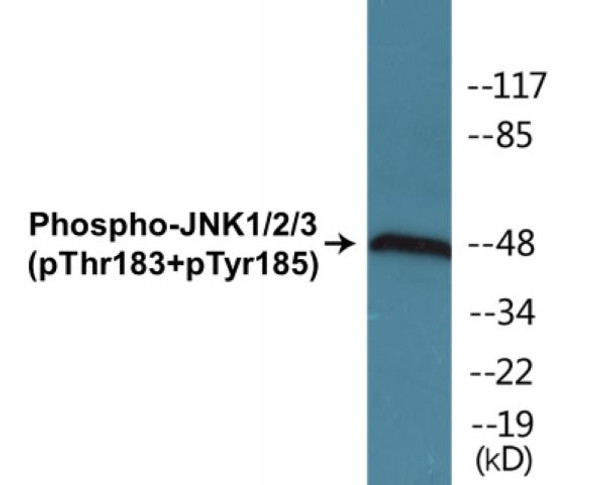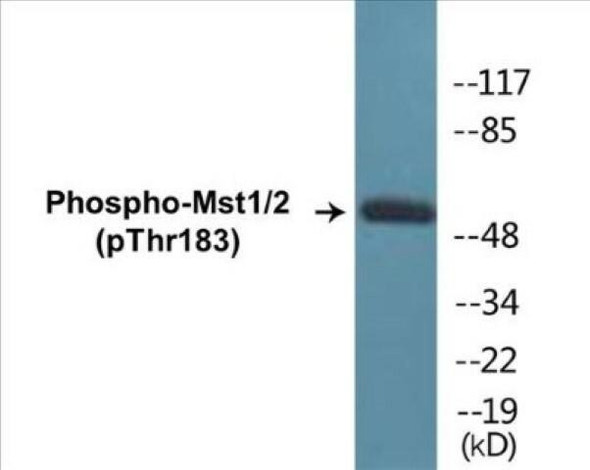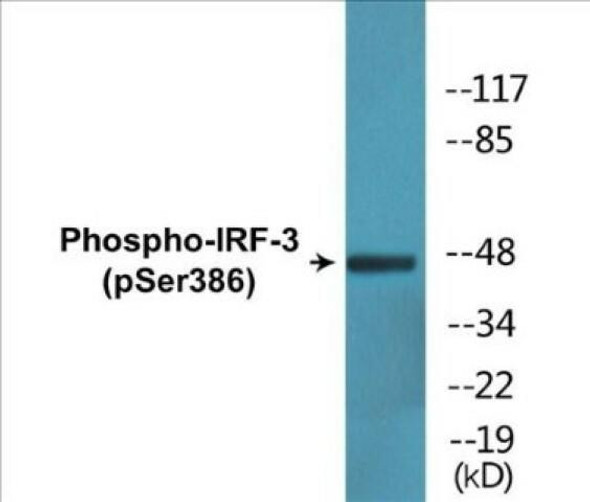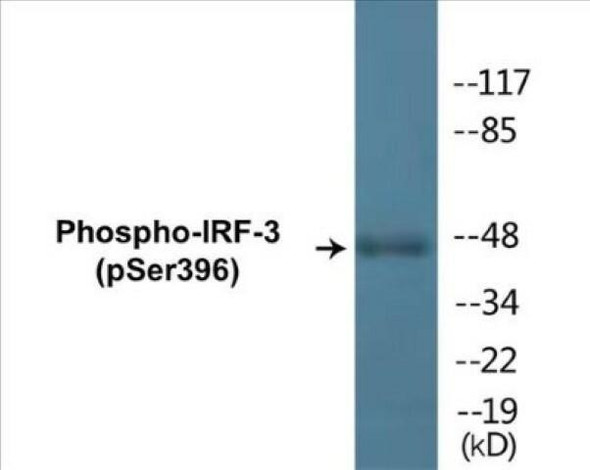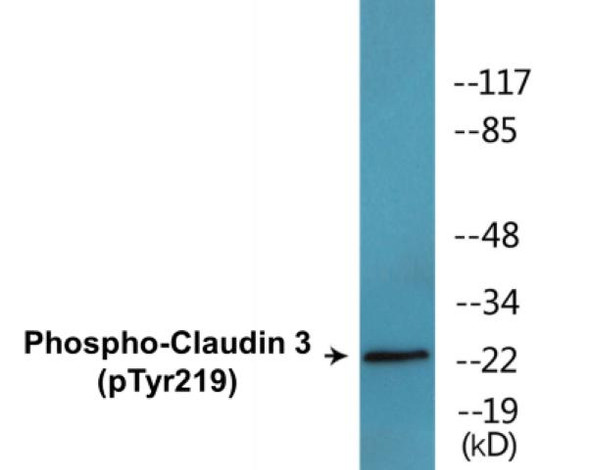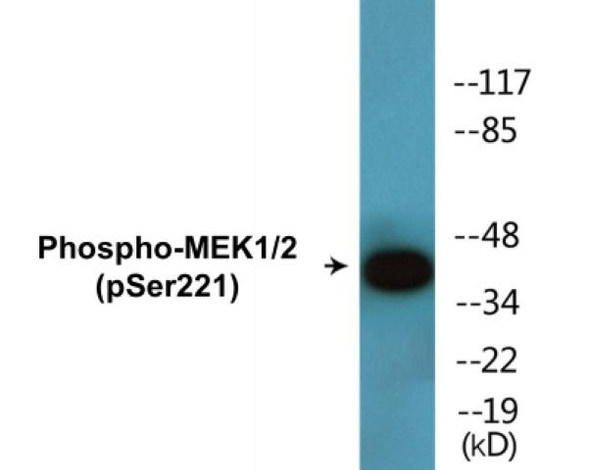Description
JNK1/2/3 (Phospho-Thr183+Tyr185)Colorimetric Cell-Based ELISA Kit
The JNK1/2/3 Phospho-Thr183/Tyr185 Colorimetric Cell-Based ELISA Kit is a powerful tool for detecting and quantifying the phosphorylation status of JNK1/2/3 at Thr183/Tyr185 residues in cell lysates. This kit offers high sensitivity and specificity, ensuring accurate and reliable results for researchers studying cellular signaling pathways and potential drug targets.JNK (c-Jun N-terminal kinase) is a member of the MAPK (mitogen-activated protein kinase) family that plays a critical role in various cellular processes, including cell proliferation, apoptosis, and stress response. Phosphorylation of JNK at Thr183/Tyr185 is known to activate its signaling cascade, leading to downstream effects on gene expression and cell fate.
By accurately measuring the phosphorylation status of JNK1/2/3, researchers can gain valuable insights into the regulation of intracellular signaling pathways and potential therapeutic targets for diseases such as cancer, inflammatory disorders, and neurological conditions. The JNK1/2/3 Phospho-Thr183/Tyr185 Colorimetric Cell-Based ELISA Kit is a valuable tool for advancing research in these areas and uncovering new opportunities for drug development and personalized medicine.
| Product Name: | JNK1/2/3 (Phospho-Thr183+Tyr185) Colorimetric Cell-Based ELISA |
| Product Code: | CBCAB00421 |
| ELISA Type: | Cell-Based |
| Target: | JNK1/2/3 (Phospho-Thr183+Tyr185) |
| Reactivity: | Human, Mouse, Rat |
| Dynamic Range: | > 5000 Cells |
| Detection Method: | Colorimetric 450 nm |
| Format: | 2 x 96-Well Microplates |
The JNK1/2/3 (Phospho-Thr183+Tyr185) Colorimetric Cell-Based ELISA Kit is a convenient, lysate-free, high throughput and sensitive assay kit that can detect JNK1/2/3 protein phosphorylation and expression profile in cells. The kit can be used for measuring the relative amounts of phosphorylated JNK1/2/3 in cultured cells as well as screening for the effects that various treatments, inhibitors (ie. siRNA or chemicals), or activators have on JNK1/2/3 phosphorylation.
Qualitative determination of JNK1/2/3 (Phospho-Thr183+Tyr185) concentration is achieved by an indirect ELISA format. In essence, JNK1/2/3 (Phospho-Thr183+Tyr185) is captured by JNK1/2/3 (Phospho-Thr183+Tyr185)-specific primary antibodies while the HRP-conjugated secondary antibodies bind the Fc region of the primary antibody. Through this binding, the HRP enzyme conjugated to the secondary antibody can catalyze a colorimetric reaction upon substrate addition. Due to the qualitative nature of the Cell-Based ELISA, multiple normalization methods are needed:
| 1. | A monoclonal antibody specific for human GAPDH is included to serve as an internal positive control in normalizing the target absorbance values. |
| 2. | Following the colorimetric measurement of HRP activity via substrate addition, the Crystal Violet whole-cell staining method may be used to determine cell density. After staining, the results can be analysed by normalizing the absorbance values to cell amounts, by which the plating difference can be adjusted. |
| Database Information: | Gene ID: 5599/5601/5602, UniProt ID: P45983/P45984/P53779, OMIM: 601158/602896/602897/606369, Unigene: Hs.138211/Hs.654461/Hs.125503 |
| Gene Symbol: | MAPK8/9/10 |
| Sub Type: | Phospho |
| UniProt Protein Function: | JNK1: a protein kinase of the MAPK family that is potently activated by a variety of environmental stresses, including UV and gamma radiation, ceramides, pro-inflammatory cytokines and, in some instances, by growth factors and GPCR agonists. Substrates include a number of transcription factors, primarily components of AP-1 such as c-Jun and ATF2, thus regulating AP-1 transcriptional activity. In T- cells, JNK1 and JNK2 are required for polarized differentiation of T-helper cells into Th1 cells. Binds to at least four scaffolding proteins, JIP-1, -2, -3 and -4. Activity increased in obesity. Inhibition or mouse knockout increases insulin sensitivity. Part of NFB pathway involved in inflammation and cancer, and signals downstream of Ras, though possibly as an apoptotic negative regulator of growth. Four alternatively-spliced isoforms have been described. |
| UniProt Protein Details: | Protein type:Kinase, protein; EC 2.7.11.24; Protein kinase, CMGC; Protein kinase, Ser/Thr (non-receptor); CMGC group; MAPK family; MAPK/JNK subfamily; JNK subfamily Chromosomal Location of Human Ortholog: 10q11.22 Cellular Component: nucleoplasm; mitochondrion; cytosol; nucleus Molecular Function:protein serine/threonine kinase activity; protein binding; enzyme binding; histone deacetylase regulator activity; histone deacetylase binding; JUN kinase activity; ATP binding Biological Process: nerve growth factor receptor signaling pathway; apoptosis; positive regulation of apoptosis; rhythmic process; stress-activated MAPK cascade; toll-like receptor 3 signaling pathway; protein amino acid phosphorylation; toll-like receptor 10 signaling pathway; toll-like receptor 5 signaling pathway; regulation of protein localization; regulation of transcription factor activity; response to stress; JNK cascade; negative regulation of protein binding; toll-like receptor 4 signaling pathway; response to UV; ossification; regulation of histone deacetylation; MyD88-independent toll-like receptor signaling pathway; peptidyl-threonine phosphorylation; regulation of circadian rhythm; JUN phosphorylation; toll-like receptor 2 signaling pathway; MyD88-dependent toll-like receptor signaling pathway; peptidyl-serine phosphorylation; response to cadmium ion; toll-like receptor signaling pathway; innate immune response; toll-like receptor 9 signaling pathway; negative regulation of apoptosis |
| NCBI Summary: | The protein encoded by this gene is a member of the MAP kinase family. MAP kinases act as an integration point for multiple biochemical signals, and are involved in a wide variety of cellular processes such as proliferation, differentiation, transcription regulation and development. This kinase is activated by various cell stimuli, and targets specific transcription factors, and thus mediates immediate-early gene expression in response to cell stimuli. The activation of this kinase by tumor-necrosis factor alpha (TNF-alpha) is found to be required for TNF-alpha induced apoptosis. This kinase is also involved in UV radiation induced apoptosis, which is thought to be related to cytochrom c-mediated cell death pathway. Studies of the mouse counterpart of this gene suggested that this kinase play a key role in T cell proliferation, apoptosis and differentiation. Five alternatively spliced transcript variants encoding distinct isoforms have been reported. [provided by RefSeq, Jun 2013] |
| UniProt Code: | P45983 |
| NCBI GenInfo Identifier: | 2507195 |
| NCBI Gene ID: | 5599 |
| NCBI Accession: | P45983.2 |
| UniProt Secondary Accession: | P45983,Q15709, Q15712, Q15713, Q308M2, B5BTZ5, B7ZLV4 D3DX88, D3DX92, |
| UniProt Related Accession: | P45983 |
| Molecular Weight: | 427 |
| NCBI Full Name: | Mitogen-activated protein kinase 8 |
| NCBI Synonym Full Names: | mitogen-activated protein kinase 8 |
| NCBI Official Symbol: | MAPK8 |
| NCBI Official Synonym Symbols: | JNK; JNK1; PRKM8; SAPK1; JNK-46; JNK1A2; SAPK1c; JNK21B1/2 |
| NCBI Protein Information: | mitogen-activated protein kinase 8; MAP kinase 8; JUN N-terminal kinase; c-Jun N-terminal kinase 1; stress-activated protein kinase 1; stress-activated protein kinase 1c; mitogen-activated protein kinase 8 isoform JNK1 beta2; mitogen-activated protein kin |
| UniProt Protein Name: | Mitogen-activated protein kinase 8 |
| UniProt Synonym Protein Names: | JNK-46; Stress-activated protein kinase 1c; SAPK1c; Stress-activated protein kinase JNK1; c-Jun N-terminal kinase 1 |
| Protein Family: | JNK-interacting protein |
| UniProt Gene Name: | MAPK8 |
| UniProt Entry Name: | MK08_HUMAN |
| Component | Quantity |
| 96-Well Cell Culture Clear-Bottom Microplate | 2 plates |
| 10X TBS | 24 mL |
| Quenching Buffer | 24 mL |
| Blocking Buffer | 50 mL |
| 15X Wash Buffer | 50 mL |
| Primary Antibody Diluent | 12 mL |
| 100x Anti-Phospho Target Antibody | 60 µL |
| 100x Anti-Target Antibody | 60 µL |
| Anti-GAPDH Antibody | 60 µL |
| HRP-Conjugated Anti-Rabbit IgG Antibody | 12 mL |
| HRP-Conjugated Anti-Mouse IgG Antibody | 12 mL |
| SDS Solution | 12 mL |
| Stop Solution | 24 mL |
| Ready-to-Use Substrate | 12 mL |
| Crystal Violet Solution | 12 mL |
| Adhesive Plate Seals | 2 seals |
The following materials and/or equipment are NOT provided in this kit but are necessary to successfully conduct the experiment:
- Microplate reader able to measure absorbance at 450 nm and/or 595 nm for Crystal Violet Cell Staining (Optional)
- Micropipettes with capability of measuring volumes ranging from 1 µL to 1 ml
- 37% formaldehyde (Sigma Cat# F-8775) or formaldehyde from other sources
- Squirt bottle, manifold dispenser, multichannel pipette reservoir or automated microplate washer
- Graph paper or computer software capable of generating or displaying logarithmic functions
- Absorbent papers or vacuum aspirator
- Test tubes or microfuge tubes capable of storing ≥1 ml
- Poly-L-Lysine (Sigma Cat# P4832 for suspension cells)
- Orbital shaker (optional)
- Deionized or sterile water
*Note: Protocols are specific to each batch/lot. For the correct instructions please follow the protocol included in your kit.
| Step | Procedure |
| 1. | Seed 200 µL of 20,000 adherent cells in culture medium in each well of a 96-well plate. The plates included in the kit are sterile and treated for cell culture. For suspension cells and loosely attached cells, coat the plates with 100 µL of 10 µg/ml Poly-L-Lysine (not included) to each well of a 96-well plate for 30 minutes at 37°C prior to adding cells. |
| 2. | Incubate the cells for overnight at 37°C, 5% CO2. |
| 3. | Treat the cells as desired. |
| 4. | Remove the cell culture medium and rinse with 200 µL of 1x TBS, twice. |
| 5. | Fix the cells by incubating with 100 µL of Fixing Solution for 20 minutes at room temperature. The 4% formaldehyde is used for adherent cells and 8% formaldehyde is used for suspension cells and loosely attached cells. |
| 6. | Remove the Fixing Solution and wash the plate 3 times with 200 µL 1x Wash Buffer for five minutes each time with gentle shaking on the orbital shaker. The plate can be stored at 4°C for a week. |
| 7. | Add 100 µL of Quenching Buffer and incubate for 20 minutes at room temperature. |
| 8. | Wash the plate 3 times with 1x Wash Buffer for 5 minutes each time. |
| 9. | Add 200 µL of Blocking Buffer and incubate for 1 hour at room temperature. |
| 10. | Wash 3 times with 200 µL of 1x Wash Buffer for 5 minutes each time. |
| 11. | Add 50 µL of 1x primary antibodies Anti-JNK1/2/3 (Phospho-Thr183+Tyr185) Antibody, Anti-JNK1/2/3 Antibody and/or Anti-GAPDH Antibody) to the corresponding wells, cover with Parafilm and incubate for 16 hours (overnight) at 4°C. If the target expression is known to be high, incubate for 2 hours at room temperature. |
| 12. | Wash 3 times with 200 µL of 1x Wash Buffer for 5 minutes each time. |
| 13. | Add 50 µL of 1x secondary antibodies (HRP-Conjugated AntiRabbit IgG Antibody or HRP-Conjugated Anti-Mouse IgG Antibody) to corresponding wells and incubate for 1.5 hours at room temperature. |
| 14. | Wash 3 times with 200 µL of 1x Wash Buffer for 5 minutes each time. |
| 15. | Add 50 µL of Ready-to-Use Substrate to each well and incubate for 30 minutes at room temperature in the dark. |
| 16. | Add 50 µL of Stop Solution to each well and read OD at 450 nm immediately using the microplate reader. |
(Additional Crystal Violet staining may be performed if desired – details of this may be found in the kit technical manual.)
| Lai et al. | Hispidin in the Medicinal Fungus Protects Dopaminergic Neurons from JNK Activation-Regulated Mitochondrial-Dependent Apoptosis in an MPP+-Induced In Vitro Model of Parkinson’s Disease | Neuroscience and Neuropharmacology 2023 | PubMed ID: 36771255 |

